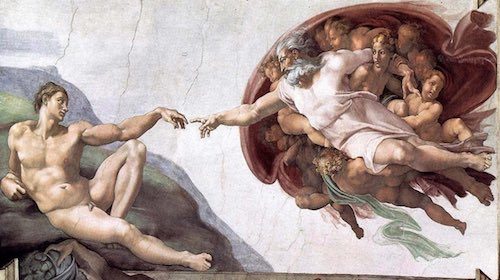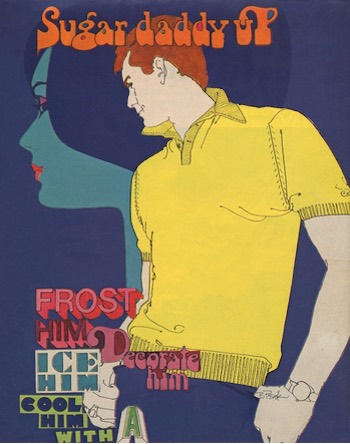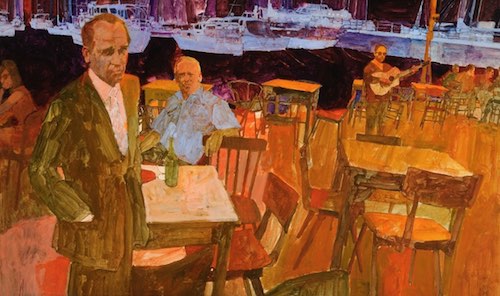We are pleased to introduce the first of a biweekly column on art and illustration by art critic and historian David Apatoff. David will share exciting and interesting illustrations, reveal colorful stories about Post artists and their methods, and offer insights into why art and illustration are such an important part of our culture. We hope you enjoy it!
For 10,000 years, artists were hired by the wealthy and powerful. Kings, priests, pharaohs, and popes commissioned art for cathedrals, palace walls, sacred caves, and public spaces.

Then, gradually, this market for art faded away. Kings began to vanish from the Earth; churches stopped commissioning altar paintings and chapel ceilings; princes no longer hired artists for flattering portraits or murals of glorious military victories. Their castles were handed over to public trusts in exchange for tax deductions.
Artists had to find new places to sell their art.

Fortunately, a new breed of sponsor arose to replace those historical patrons of the arts. The growth of capitalism and the invention of the corporation gave private citizens the wealth to commission art. Businesses began purchasing “commercial art.” Even more importantly, new technologies for mass-producing pictures and distributing them to wide audiences enabled working families — whether rich or poor — to enjoy great art in their homes. Rather than compete to become a royal painter, artists could now publish millions of copies of a picture and sell them to large numbers of customers for pennies apiece.
In the 19th century, The Saturday Evening Post was one of a small handful of American magazines, along with Harper’s Weekly, Century, and Life, that were densely printed black-and-white periodicals with wood engravings for illustrations.
By the 20th century, the magazine industry had blossomed into dozens of popular and well-designed color periodicals. Historians have dubbed this the “magazine revolution.” The quality of reproductions, and the newly sophisticated vehicles for delivering them to the public, transformed the economics of art and inspired new bursts of creativity. Public enthusiasm for new pictures grew dramatically as technology for reproducing pictures in magazines improved.

The Post soon became the most widely circulated magazine in America. This was largely due to editor George Lorimer’s vision of taking advantage of the newly available technologies for printing images.
The most talented artists learned they could become wealthy by creating pictures for the new mass audiences. Illustrators such as Norman Rockwell, Maxfield Parrish, J.C. Leyendecker, and Charles Dana Gibson received handsome sums illustrating magazines. Their covers became a popular topic of conversation across the country. The art inside the magazines — ranging from story illustrations to imaginative advertisement pictures — shaped popular taste, too.

Several of the images created by these illustrators became cultural icons. In this way, the modern magazine became one of the world’s greatest platforms for art.
Great painters of the era aspired to be magazine illustrators. In letters to his brother, Vincent van Gogh praised the quality of illustrations in magazines such as Harper’s Weekly and Illustrated London News, and he clipped out their drawings and pasted them in portfolios for further study. The great abstract expressionist Willem de Kooning came to America to become a commercial artist.
As the technologies continued to evolve, the next generation of illustrators was able to make images that moved and spoke. At animation studios such as Disney and Pixar, they painted with computers rather than brushes. Today, illustrators are pioneers in computer games employing virtual reality. But no matter how advanced the technologies become, illustrators continue to look back and gain inspiration from their artistic roots in magazine illustration.

With all these changes in the landscape of art, it’s fair to ask: Who was the greatest art patron of the 20th century? If we measure by the size of the audience and the influence of the art, one good candidate is The Saturday Evening Post.
The Post’s circulation in the first half of the 20th century was far greater than the audience enjoyed by any museum or private collection of the period. Every week, the Post delivered a cornucopia of pictures, not just to audiences in big cities but to people in small towns with no museums, libraries, or televisions. Many of its illustrators recognized this fact and took their artistic obligations seriously. Post illustrator Robert Fawcett said, “We represent the only view of art and beauty that millions of people get a chance to see. If we do less than our best, we cheat them.”
For many years, the weekly audience for the Post was larger than the audience for Picasso, Matisse, or any other giants of 20th century modern art. Furthermore, the art in the Post’s illustrations had more of an impact on day-to-day lives, shaping cultural identity and political beliefs in ways that museum artists never did. They drove consumer choices, sold war bonds, persuaded young men to join the army (“Uncle Sam Wants You!”), and affected our standards of beauty, patriotism, love, and ethics. And as Lionello Venturi, the foremost historian of art criticism, has pointed out, “What ultimately matters in art is not the canvas, the hue of oil or tempera, the anatomical structure and all the other measurable items, but its contribution to our life, its suggestions to our sensations, feeling and imagination.”

Several fine art critics of the 20th century have argued that in order to be accessible to a wider audience, illustrators sacrificed avant garde art principles, making illustration a lesser art form. But the passage of time has caused experts to re-examine that view. Today, illustration is increasingly respected by museums, academics, and collectors. Meanwhile, so-called “fine” art is viewed by many as esoteric, self-absorbed, and irrelevant. Noted writer and art critic Tom Wolfe said in a speech at the National Museum of American Illustration, “I feel very comfortable predicting that art historians 50 years from now … will look back upon illustrators as the great American artists of the second half of the 20th century.”
As Shakespeare proved, broad appeal to a popular audience is not incompatible with greatness.
A wealth of 20th-century illustration lies behind us, largely unexamined and underappreciated. It is one of my great pleasures to help unearth that art and consider its qualities afresh, on a level playing field with other art forms. I hope you will join me here for an interesting ride.
Become a Saturday Evening Post member and enjoy unlimited access. Subscribe now




Comments
Hello, Unfortunately, we could not find that name in our archive.
Dear editors: Did The Post ever employ an artist by the name Adeline Elizabeth Justice nee Dietrich? There are indications that she did some work on cover art. Than you for your attention to my question. Del Greanya
As a young child I would visit my grandmother in the summer. She ordered the Post. She was too busy to read in the summer due to work on their berry farm. She saved her reading for the winter. I would go through her “Post” at night and read and wonder about all the writings and art work. Now as
I approach 86 years I get the “Post” . Thank you for keeping one of the best
printed materials that all ages can read and enjoy.
David, welcome to The Saturday Evening Post’s fantastic online website. Isn’t it incredible? It’s the perfect forum for your selections and insights into 20th century art and illustration every other week.
One of my favorite artists/illustrators is Bob Peak (1927-1992) who’s legacy of art in so many fields, is most likely unmatched by anyone. I bought ‘The Art of Bob Peak’ over-sized coffee table book several years ago and had it autographed by his son, Tom Peak, who did an unbelievable job creating this book.
The movie posters, magazine covers, advertisements and more are all there in the finest quality possible. I bought my copy at a special power point screen highlight in Malibu that was spectacular. Tom narrated and told a lot of the behind-the-scenes stories on many that are fascinating.
Two of my favorite ad illustrators are Art Fitzpatrick and Van Kaufman that drew the cars (AF) and the background and people (VK) in Pontiac’s glorious print ad campaign between 1959-1971. I wrote about this in an automotive feature the POST did several weeks ago.
I got to meet both of them, 8 years apart. Since writing it, I found the 1988 letter from DMB&B that put me in contact with Mr. Kaufman in L.A. I’m going to send it to The POST soon. The biggest thrill of it all? GM was filthy rich then and sent them to the most beautiful places all over the world as locales for the ads, all expenses paid for the work they loved creating.
Always up to the minute when year to year differences mattered, Van showed me some of the ads he drew himself into I hadn’t realized previously. He also explained how Art used manipulative, sleight-of-hand optical illusion of the cars disproportionately to show them off best, yet trick the eye/brain that it WAS in complete proportion. Illustration allowed this fantasy, photography could not.